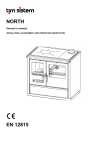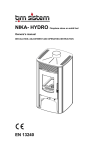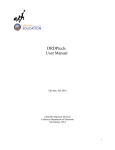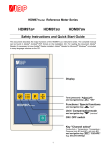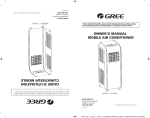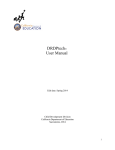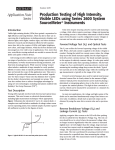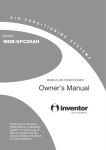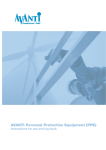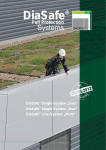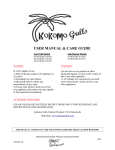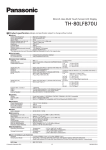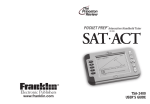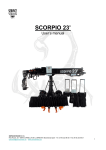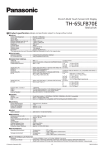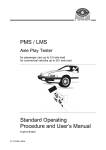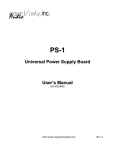Download NORTH EN 12815
Transcript
NORTH Owners’s manual INSTALATION, ADJUSTMENT AND OPERATING INSTRUCTION EN 12815 Dear Customer, We appreciate your trust wested in us and decision touse "TIM SISTEM" product. You have invested in energy-efficient and high-quality product - NORTH wood burning cooker. Your purchase will provide you long-term clean and comfortable heating with minimal maintenance. Please read these instructions carefully and completely. It’s purpose is to inform you about the installation, operation and maintenance of your stove. Keep it handy and refer to it as needed. You will find in it information that will be useful now and in the years to come. Make sure that when installing the stowe all security standards have been respected and that all gas pipes, connections between tubes and pipes and walls are connected properly. Failure to comply with these standards and carelessness during installation can result in damage to property or put your health and life in danger! Set your cooker to a safe place, away from the frequent passages and doors, somewhere near chimney and chimney connection. We wish you manypleasant moments with NORTH. TIM SISTEM d.o.o. WARNING BEFORE USE To keep your cooker working properly, it is important to read this manual and strictly stick to the instructions for use and handling. For combustion use solid fuels such as wood and wood briquettes. It is forbidden putting explosive devices and materials combustion chamber or the limited thermal furnace. It is forbidden to keep flammable materials near the stove. For proper combustion, in normal operating mode, draft in the chimney should be 10-12PA. If the draft is greater than 15Pa, the valve should be installed in the chimney. Room where the cooker is positioned must be vented regularly for the fresh air needed for combustion. Some parts of cooker heat up during operation and it takes appropriate precaution when handling it. Do not allow children to handle and play near the cooker. Only spare partes reccomended and allowed by the manufacturershould be installed on the cooker. You must not make any changes on the cooker. With first firing there might show a mild smoke, especially from the plate’s surface. It is a common appearance that occurs due to combustion deposits on the plate’s surface(corrosion protection, paint, dust, ....). The room where the cooker is should be vented during the first firing. It’s not reccomended connecting the cooker to the common chimney because it can adversely affect the required draft. Device that uses gas as fuel must notbe connected to same chimney. During firing, use protection gloves because the door handles get heated. National and local regulations for the installation of the furnace must be respected. In a case of non-copliance with instructions given in this manual, manufacturer does not take any kind of responsability for caused damage. DESCRIPTION OF THE COOKER NORTH wood burning cooker is used for heating rooms and it’s manufactured and tested according to European standard EN 12815. The upper plate of the fireplace is made of steal. Firebox doors are made of steal with fireproof glass. Connection for smoke drainis being put on the plate and connected with screws. All the materials that NORTH cooker is made can be recycled. Sealing elements are made of materials that NOT contain asbestos. Parts of the COOKER: 1. 2. 3. 4. 5. 6. 7. 8. Protection rail Hotplate Smoke exhaust Flue gas register Thermometer Oven Oven door Oven door handle 9. Wood drawer 10. Firebox door handle 11. Primary air regulator 12. Firebox door 13. Firebox 14. Secondary air regulator TECHNICAL DATA Name NORTH Use Solid fuel cooker Nominal power kW 7 efficiency % 79 Fuel Wood, wood briquets Dimensions of the cooker WxLxH mm 900x600x850 Dimensions of the fire place WxLxH mm 290x450x280 Dimensions of the oven WxLxH mm 350x475x295 kg 120 Back mm 500 Side mm 500 Front mm 800 % 0,091 mm Ø150 Weight Minimum distance from flammable materials Content CO (reduced on 13% O2) [%] Chimney connection Chimney connection position Consuption by nominal power Emission temperature Left/right upper plate kg/h 1,5 °C 239 Air regulation Primary Secondary Required draft Pa 12±2 INSTALLING THE COOKER Cooker must not be set up near the wooden parts, refrigeration parts, plastic furniture and other flammable materials because during operation (during fuel combustion) it achieves high operating temperature that is distributed on the outside of the furnace. Minimum distance between the stove and the surrounding elements is 50 cm, and the from flamable materials 80 cm. If the ground on which you set the cooker is made of easily flammable material (wood, warm floor, laminate ...) you need to set under the cooker a protetion sheet metal - lateral width of 10 cm and 50 cm in the front. Because of it’s weight, the cooker must be installed on the appropriate base. If it does not satisfie necessary standard, you must take appropriate measures to make it possible (eg, weight distribution). Connect the cooker to a chimney and flue pipes through the connector on top of the furnace, so as to ensure adequate tightness and flow of smoke from the stove to the chimney. Flue pipe must not be drawn too deeply into the chimney that would reduce the cross sectional area and thus undermined draft in the chimney. Do not use reducers which reduce the cross section of pipe smoke. The cooker requires insertion of fresh air in the room where it is installed, with surface openings for insertion of fresh air should not be less than 0.4 dm ². The unit for fresh air set outside the common room for ventilation, which must be insured by door and gride. Fans that work in the same room where the cooker is installed may make interference wit the the cooker. Also, all devices or ventilation that creates negative pressure in the room where the cooker is installed, must be set in the way that does not make decompression that prevents normal operation of the furnace. Before installing the cooker, check the chimney drafts because it is a key factor in the proper functioning of the cooker. Draft depends on the proper opration of the chimney and meteorological conditions. One of the easiest ways to check the draft in the chimney is with a candle flame, as shown in Figure 2 . Put a candle near the chimney connection drain. If the flame bends towards drain, the draft is satisfying (Figure 2b). If the flame doesn’t bend or bends a little, that indicates poor draft(Figure 2a). If there is poor draft in the chimney (Figure 2a), check the chimney operation. The chimney should be located inside the building, and if it’s located on the external walls of the building, it’s recommended insulation chimney. Figure 2a. Figure 2b. Disadvantages of the chimney (Figure 3): ` 1. The chimney is higher than the top of the roof, a small cross section of the output, 2. Excessive slope 3. A sudden change of direction of the flue channel 4. Stove or some other device connected to the same flue channel, 5. Bulges in the flue channel 6. Cracks 7. Alien body or accumulated grime, 8. Tube inserted too deeply, 9. Fan or other device that creates a vacuum in the room 10. Unsealed or opened cleaning hole Figure 3. IGNITION AND LIGHTING Before the first firing, wipe all painted surfaces withclean and dry cloth, in order to avoid burning impurity on the oven and creation of unpleasant smells. Start the fire in the stoveby following order: • open the fire door, • place the fluel into the fire place (chopped wood to non greasy wrinkled paper) • light a fire • leave open primary air regulator until the flame gets stable and after having stabilized the flame,control burning intensity with draftsregulator (Fig. 1, pos. 11) • secondary air regulator leave opened until the flame gets stable and after having stabilized the flame, control burning intensity with regulator (Fig. 1, poz.14) • close the firebox door, • after creating a basic flame insert larger pieces of wood or briquettesin the firebox, and close the firebox door. If you use briquettes as a fuel, you must wait that all biquettes are then reduce the draft in half. lit and • when adding fuel, (Fig. 1, pos. 12) open the fire door step by step wait for 4-5 seconds, and then slowly open it wide. Do not open the doorsuddenly, when there’s a strong flame in the combustion chamber, it may come to it’s spreaading into the room. Regulating the draft in the cooker, you can regulate temperature, power and the combustion of fuel, and this is done by running draft regulator on the firebox door (Fig. 1, pos. 11). Combining primary air through the regulator onthe firebox door and secondary air over the leverage above the firebox door (Fig. 1, pos. 14) you get desired combustion . cooker contains auxiliary tools in order to facilitate its maintenance. Recommended fuels are briquettes and wood. You must not use gasoline and similar fuels, because by using liquid fuels you crate conditions for damaging the stove and to provoce an explosion. Attention! • Do not use organic wasteas fuel, food residue, plastic, combustible or explosive materials, which combustion disturbs the proper functioning of the cooker and may cause damage and environmental pollution. • Increased ambient temperature can cause poor air circulation (drafts) in the chimney, and in that case is recommended more frequent firing in smaller quantities. • Avoid using the cooker when there are bad weather conditions for the cooker andin the case of strong wind, because it reflects the required vacuum in the chimney. In these cases there may occure potential return of smoke in the room where the cooker is placed. Ignition is difficult then. We recommend firing every hour with the amount of fuel in the combustion chamber up to 15cm with cross stacking wood for better airflow. After each refilling, it’s reccomender to leave the oven running in full speed for 30 minutes,in order to destroy all volatile elements that may cause condesation in the cooker. For correct cooker operation it takes: - Regular cleaning of the cooker and chimney Regular room ventilation for better combustion Regular ash tray cleaning Accumulated slag and unburned material regularly remove from the grid WORKING REGIMES There are four working regimes, which could be selected by adjusting the draught in the cooker. Combined working regime - working regime in which it could be cooked in the oven, cooked on the top of the hotplate and heat the room at the same time. It is necessary to push the flue gas register handle towards the inside of the cooker, move primary air regulator to create medium inlet of the air. Quick cooking - during this process it is the hotplate heats up intensively and to be able to do that with small quantity of fuel, draw flue gas register handle completely outside, oven door should be shut and move primary air regulator to create medium inlet of the air. Heating for this regime it would be recommended to use wood or coal. If the coal is been used it would require more frequent firing in order to create the ember which would intensively heat the hotplate of the cooker. Push the flue gas register handle towards the inside of the cooker, move primary air regulator to create medium inlet of the air and the oven’s door closed. Baking for this regime push the flue gas register handle towards the inside of the cooker, move primary air regulator to create medium inlet of the air and the oven’s door closed after putting the baking pan inside. HANDLING THE COOKER OPERATION Start a fire with a moderate flame in order to avoid thermal shocks. The following amounts of wood are inserted only after the previous volume burn. Do not allow that ashes and unburned accumulate on the grid and to ta pit that way. Clean the grid. Open the door slowly and carefully, allowing that way equalization of pressure in the firebox and in the room, otherwise itmight cause the smoke in the room. The cooker is designed and intended for use with firebox door constantly closed, except during refueling. Do not open the door with no need. The wood must be a maximum of 20% moisture content for maximum fire effect. Otherwise the tar gets separated which with water steam may crate creosite. If that happens in some bigger quantitiy, it may lead to a chimney fire. You will most easily recognize chimney fire by: the characteristic sound that comes out of the chimney like loud roaring, visible flames coming out of the chimney, high ambient temperatures of surrounding walls and the characteristic smell of burning. If there comes to the fire do the following: • Immediately call the fire squad • muffle oxygen supply to the chimney and turn off the cooker • Do not insert anything into the chimney and make sure that the fire does not spread to the wooden construction or other combustible materials in its nearby. • DO NOT pour water into the cooker or chimney • A fire in the chimney can be extinct only with dry powder • Water can extinguish only a surrounding material • Do not cool the surrounding walls with water Note: If the fire in the cooker for some reason becomes dangerously strong take the following measures: close air dampers that provide air for combustion. If it is necessary put in the firebox specially prepared sand for this purpose or non-combustible fire blanket. It would be good to have a fire extinguisher. Before the second charging, clean the gridin order to provide the fresh air. Regularly clean the ash pan making sure that there is always a place for ashes. The furnace is designed to operate in periodic mode. To maintain the required nominal power, combustion chamber is periodically filled with prestabled amount of fuel. Furnace is not designed to operate in continuous modeof heating or in accumulating temperature mode. CLEANING AND MAINTENANCE Regular and proper cleaning allows proper operation and long life of the stove. All cleaning the interior or exterior surfaces are always performed in a cold oven. Cleaning exterior surfaces - is done with a soft cloth that will not damage the surface of the stove. Cleaners of chemical origin can damage the surface of the fire place and cannot be used. Painted surfaces must not be cleaned with abrasive products. Cleaning inter surfaces –when cleaning use protective gloves. Clean the bottom of the ovenfrom accumulated ash and pick up small unburned pieces of the grid, clean the ashtray and ash accumulated in the interior of the fireplace. Cleaning glass surfaces - glass on the firebox may get dirthy during the operation.. For cleaning use a mild detergent. Do not use abrasive cleaners because they can damage the surface of the glass. Clean the glass only when cool. Cleaning and maintenance of the chimney - chimney cleaning and control is recommended at least once a year and after a long downtime. Regular maintenance and control of the chimney will prevent the occurrence of fire and poor operation of the stow. Malfunction. Recommendations for its elimination The following table shows the most common defects and recommendations for their removal. Table: Showing the most common malfunctions, possible causes and ways of eliminating it. Malfunction Oven heats poorly Difficulties in lighting fire Smoke reenters into a room Possible cause improper handling, Poor uptake Howe to remove it Read carefully and follow the instructions. Inthe case that despite all instructionshave been respected, malfunctions are still not removed, call the customer service Closed regulator of air supply, Wet wood, Lack of oxygene Open the regulator of air supplyand provide a supply of a primary air Use a dry wood Ventilate a room in order to provide a supply of fresh air Closed regulator of air supply, Insufficient draft, Remainings of ashes on a grid Open the regulator of air supplyand provide a supply of a primary air Read carefully the instructions and apply advices how to provide a draft Clean the grid Glass on a firebox door are getting sooty for a while Wet wood Too much fuel Insufficient draft Closed intake of secundary air Use a dry wood Check a suggested quantity of a fuel provided in a user’s manual Check a connection with a chimney Read carefully the instructions and apply advices how to provide secundary air GENERAL RECOMMANDATION If you have fullfield all the recommendations for installation, operation and control of cleaning, giveen in this manual, the stove is now tested, safe device for household use. Before installing the stove, remove the package. Be aware of potential injuries because the wooden slats are connected with nails. Dispose a plastic bag in accordance with the regulations. Old stove you do not want to use anymore, dispose to designated areas in accordance with the regulations. All complaints, perceived failure or malfunctioning stoves, should be reported to the factory or authorized service center by telephone or in written, only with fiscal receipt. All contact information provided at the end of this guide. Any malfunction of the cooker, must be removed by the manufacturer’s service only. If unauthorized persons carry out any servicing or repairs and alterations to the stove, the owner loses the right to the manufacturer's warranty. Supply of spare parts has to be done viamanufacturer’sservice, based on the position and image of this manual. The manufacturer does not assume any responsibility if the buyer fails to comply with the instructions for use and installation of the stove. ADVICES FOR ENVIRONMENT PROTECTION PACKAGING Packaging material is 100% recyclable. For a waste disposal of, act in accordance with local regulations. Packaging material (plastic bags, polystyrene parts-polystyrene, etc.). Should be kept away from children, as a potential source of danger. Take care of safe removing and disposing of wooden boards because they are connected with nails. PRODUCT The device is made of materials that can be recycled. When disposing the waste,act in accordance with enviromental laws in effect. Use only the recommended fuel. It is forbiden burning an inorganic and organic materials (plastics, plywood,textile, oiled wood, etc..), because the combustion releases carcinogenic materials and other toxics. SOLID FUEL COOKER “NORTH” List of all Positions on the "NORTH" cooker 1. Smoke exhaust 2. Hotplate carrier 3. Cookers frame 4. Flue gas register handle 5. Oven protector 6. Flue gas register 7. Rear inner panel 8. Rear exterior panel 9. Partition firebox panel 10. Rear carrier side panel 11. Inner side plate 12. Carrier side brick 13. Assembly oven 14. Deflector below the oven 15. Front carrier side panel 16. Oven grill 17. Side panel 18. Bottom of the oven 19. Corps carrier 20. Bottom plate 21. Mount drawer slide 22. Base assembly 23. Stationary slider 24. Moving slider 25. Decorative drawers mask 26. Wood drawer assembly 27. Wood drawer handle 28. Oven door 29. Oven door glass 30. Thermometer 31. Doors handle 32. Primary air regulator 33. Firebox door 34. Primary air box 35. Firebox door glass 36. Secondary air regulator 37. Decorative plate 38. Grill 39. Front plate assembly 40. Front plate protector 41. Side brick 42. Secondary air box 43. Side panel protector 44. Protection rail carrier 45. Protection rail 46. Hotplate 47. Back brick 48. Uper brick DIMENSIONS OF THE COOKER















